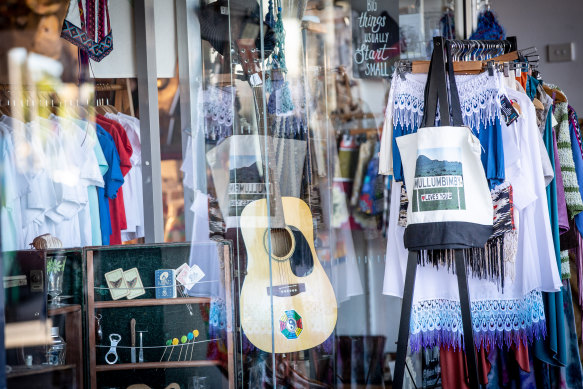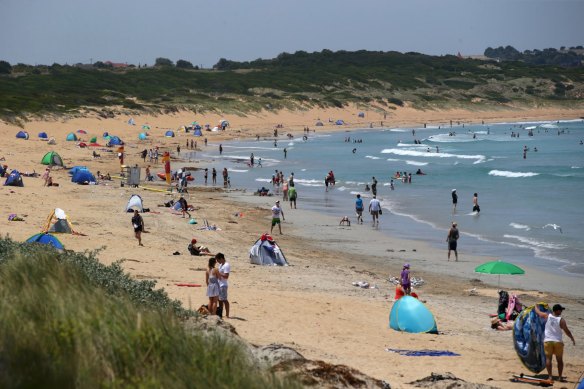- Exclusive
- National
- Vaccination
This was published 11 months ago
‘Lingering mistrust’ as child vaccination rates fall for second year
By Aisha Dow and Angus Thomson
Australia’s childhood vaccination rates have fallen for the second consecutive year, in a trend that concerned public health experts believe is linked to shortages in bulk-billing GPs and increased distrust in vaccines.
After several years of rising uptake, the proportion of Australian five-year-olds fully vaccinated with routine inoculations – including for polio, measles and hepatitis B – has fallen 1.4 per cent, from a peak of 94.8 per cent in 2020, to 93.4 per cent in 2022.

The NSW town of Mullumbimby is a town long known for vaccine refusal.Credit: Paul Harris
Pockets of much lower vaccine coverage have persisted in communities known for more “alternative” vaccine views, including the Noosa hinterland in Queensland and the New South Wales North Coast area that takes in Mullumbimby, Byron Bay and Lennox Head.
Associate Professor Frank Beard, with the National Centre for Immunisation Research and Surveillance, which published the latest data, said the ongoing national decline posed a concern given Australia was now well through the worst of the pandemic disruptions.
“It suggests that we need to do something to be clear what’s causing that, and to address it, not just sort of let it slide,” Beard said.
Until recently, Australia has not had a system of tracking vaccine sentiment, so there are uncertainties about what has caused the downturn, experts say. However, Beard and others believe answers lie in problems getting into GPs and a small shift in public attitudes towards vaccines.
“Some of the research that our social science team has done … suggested that the pandemic has had a polarising effect on vaccination attitudes,” Beard said.
Leading vaccine uptake expert Professor Julie Leask, from the University of Sydney, said some communities had experienced tough COVID-19 restrictions that “may have compounded a lingering mistrust in emblems of public health like vaccination”.
“They had more police out. They had helicopters out. They had the military out … They were the ones who were having to go to work to provide the essential services that supported the rest of the city,” she said.
Leask said some families were delaying or skipping GP visits because of financial pressures, as fewer GPs bulk-billed.
Even places such as the NSW North Coast, sometimes labelled the “anti-vax capital of Australia”, were experiencing GP shortages that could be contributing to vaccine take-up, Leask said.
“There are reports that it has become harder for families to get vaccination appointments, specifically in places like the North Coast – regional [areas] with fewer GP practices with their books open, or where maternal and child health services have been depleted for various reasons,” she said.
“We cannot just blame it on vaccine refusal.”
The area around the NSW North Coast town of Byron Bay has the nation’s second-lowest rate of two-dose vaccination for measles, mumps and rubella for children aged two years, at 79.68 per cent.
The lowest rate was detected in Queensland in the Noosa hinterland. Lower rates were also detected in the state’s far north, the Daintree region, Gold Coast hinterland and Surfers Paradise, and in the Alice Springs and Barkly areas in the Northern Territory, which includes Tennant Creek.
In NSW, lower rates were detected in the Tweed Valley, Merrylands and Guildford in Sydney and Dural and Wisemans Ferry on Sydney’s outskirts.
In Victoria – which generally has higher child vaccination rates – the areas around Loddon and Elmore near Bendigo, Creswick, Daylesford and Ballan, and Manningham East and Darebin North in Melbourne reported rates below the national average.
In Western Australia, the north west – particularly the West Pilbara –had the lowest rate of child vaccination, along with Margaret River, Busselton and Mundaring.
The highest rate in Australia for two-dose vaccination for measles, mumps and rubella for children aged two years was detected around the towns of Sorell and Dodges Ferry in southern Tasmania, and Warrnambool in regional Victoria.

Warrnambool, on Victoria’s west coast, has high rates of childhood vaccination.Credit: Damian White
Dr Debra King, a Port Macquarie GP and the Royal Australian College of General Practitioners’ North Coast representative, said she believed vaccine refusal rather than access remained the major issue on the NSW North Coast.
“There’s a lot of vaccine hesitancy on the [NSW] North Coast, particularly in certain areas – it’s been that way for a long time,” she said. “I don’t believe it’s a lack of access – GPs have access to vaccines, community nurses have access to vaccines.”
King said the vaccination coverage was worrying and that health officials were predicting a summer outbreak of whooping cough, a highly contagious infection that Australian children can be vaccinated against for free at two months, four months, six months, 18 months, four years and 12-13 years (through school-based vaccination programs).
“Children aren’t fully protected from whooping cough until they have received all their vaccines … we need to make sure the coverage is strong, so we are protecting those who aren’t protected,” King said.
“I’ve worked during the previous outbreak of whooping cough, and it just runs rampant through the schools.”
In the past two years, the proportion of 15-year-old Australian girls and boys who had received at least one dose of the human papillomavirus (HPV) vaccine by their 15th birthday also slipped 1.3 per cent and 1.8 per cent respectively, to 85.3 per cent and 83.1 per cent.
The vaccine protects against the types of HPV that cause more than 90 per cent of cervical cancers.
Beard said the same factors impacting take-up of vaccinations among younger children were probably at play, as were disruptions to school vaccination programs because of school closures caused during the COVID-19 pandemic.
Get the day’s breaking news, entertainment ideas and a long read to enjoy. Sign up to receive our Evening Edition newsletter.